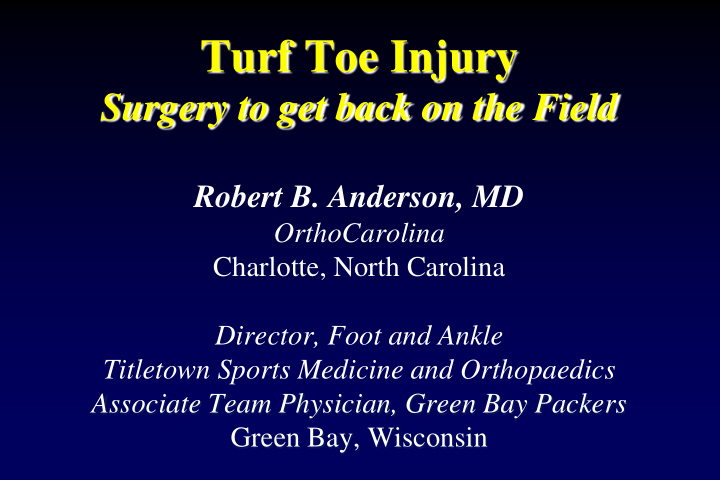



Turf Toe Injury Surgery to get back on the Field Robert B. Anderson, MD OrthoCarolina Charlotte, North Carolina Director, Foot and Ankle Titletown Sports Medicine and Orthopaedics Associate Team Physician, Green Bay Packers Green Bay, Wisconsin
Disclosures Consulting/Royalties: Wright Medical, DJO, Arthrex, Zimmer Biomet Consulting: Amniox, Diamond Orthopaedic
Turf Toe = Classic Pathology Soft tissue injury 2 ° hyperextension – Disruption of FHB and plantar complex distal to sesamoids – Variable in degree and extent = complete vs partial
Result of Hyperextension Injury • Can be major soft l Defect tissue disruption FHL –Loss of plantar restraints Sesamoid
Not Just Hyperextension = Variable Injury Patterns Increasing • Consider force and what is ruptured – Valgus force – “medial turf toe” is most common – MCL/Abd Hall tendon rupture »May lead to traumatic bunion/progressive hallux valgus
Clinical Examination • Standing alignment and toe posture • FHL function • Lachman exam – Vertical instability = lack of plantar restraints
Radiographic Evaluation • Mandatory in the evaluation of turf toe • Comparison AP of opposite side recommended • Assess for proximal migration of sesamoids
Radiographic Evaluation Normal Injured • Forced dorsiflexion lateral view – Assess distance from distal tibial sesamoid to base of phalanx (nl avg: 8mm)
Flouroscopy Invaluable • Assess trailing motion of the sesamoids with dorsiflexion of the hallux; instability patterns – Educational to patient
Treating the Turf Toe??? • Many can be treated nonoperatively – R.I.C.E. – Walker boot or short leg cast with toe spica »Plantarflex hallux – Turf toe plate/tape
Surgical Treatment – Who Needs It? • “A Gestalt” • My threshold for surgical repair has lowered over the years – Gross instability » + Lachman » Excessive DF – Progressive clawing
Why Early Surgical Repair? • Restoration of anatomy is necessary for restoration of function • Avoid late deformity
Return to Play Quickly? • Severe soft tissue injuries recover more predictably with surgical repair – However I am not sure a Bowl game in 3 weeks is feasible…
Surgical Technique • Exposure through medial or J-incision
Surgical Technique • Exposure through both medial and plantar medial incisions – Less traction on nerve – Improved lateral exposure – Better wound healing plantar
Surgical Technique • Extensile exposure and prone positioning – Good for chronic situation and both sesamoids retracted
Extensile vs 2-Incision Approach = Identify and Protect the Nerves!
Surgical Technique • Transect abductor tendon - identify defect in plantar capsule, condition of the FHL tendon and sesamoids
Surgical Technique • Primary repair to soft tissue on base of proximal phalanx usually possible
Surgical Technique • Advance capsule and repair – 2-0 nonabsorbable – 10-15 ° plantarflexion • Work from lateral to medial – Avoid nerve
Direct Repair
Surgical Technique • If no soft tissue attachments for primary repair – Distal: suture anchors in proximal phalanx – Proximal: transverse drill hole in distal sesamoid
Surgical Technique • Avoid supination when placing suture anchors in proximal phalanx – Be central – use flouro
Surgical Technique • Complete repair with advancement of medial capsule – Repair abductor hallucis tendon
Surgical Technique Check nerve one last time prior to closure
Surgical Technique Postop Preop (injured) Compare to Contralateral (normal)
Case – Turf Toe Variant • 28 y/o football player • Valgus stress with axial load • Pain over tibial sesamoid – Diastased bi-partite Pre-injury • Loss of push-off strength Post-injury
Case – Turf Toe Variant • Soft tissue avulsion from tibial sesamoid • Partial sesamoidectomy – Distal fragment
Case – Turf Toe Variant • Repair via drill hole in remaining sesamoid
Case – Turf Toe Variant • Repair via drill hole in remaining sesamoid
Case – Turf Toe Variant • 27 y/o lineman • Valgus stress with axial load • Progessive hallux valgus – Can not “ cut ” or push-off – MRI: medial capsular rupture
Case: Traumatic hallux valgus • Treatment – Modified McBride bunionectomy with adductor tenotomy and repair of medial defect
Postoperative Management • Delicate balance between protection and early ROM – Immobilize for 5-7 days → passive plantar flexion (keep sesamoids moving) • 2 weeks NWB then walker boot • Active plantar flexion at 2 wks, dorsiflexion at 6-8 wks • Accommodative shoe with insert/plate at 8 weeks and initiate active ROM
Postoperative Management Most run at 2 months; RTP at 3 months • Taping, shoewear modifications » • “Sore” for a year – risk for hallux rigidus Prevent Dorsiflexion
References Anderson, R: Surgical management of the turf toe. Techniques in Foot and Ankle Surgery. 1. 2003 Anderson R, Watson T.: Turf toe injuries. In Advances in Foot and Ankle Reconstruction. 2. AAOS 2003 Frimenko RE, Lievers W, Coughlin MJ, Anderson RB, Crandall JR, Kent RW: Etiology and 3. biomechanics of first metatarsophalangeal joint sprains (turf toe) in athletes. Crit Rev Biomed Eng. 2012; 40 (1); 43-61 Hunt KJ, McCormick JJ, Anderson RB: Management of forefoot injuries in the athlete. 4. Operative Techniques in Sports Medicine . Publication Date: April 2009. McCormick JJ, Anderson RB: The Great Toe: Failed Turf Toe, Chronic Turf Toe, and 5. Complicated Sesamoid Injuries. Foot Ankle Clin. 2009 Jun; 14 (2): 135-150 McCormick JJ, Anderson RB: Rehabilitation following turf toe injury and plantar plate 6. repair. Clin Sports Med. 2010 Apr; 29 (2): 313-23 McCormick JJ, Anderson RB: Turf toe: anatomy, diagnosis and treatment. Sports Health 7. 2010 Nov; 2 (6): 487-94 Watson T, Anderson R, Davis W: Periarticular injuries to the hallux metatarsophalangeal 8. joint in athletes. Foot and Ankle Clinics, 5 (3): 687-713, 2000
Thank You
Recommend
More recommend